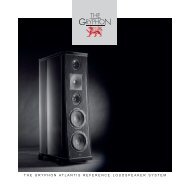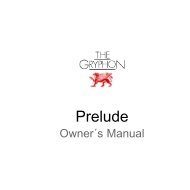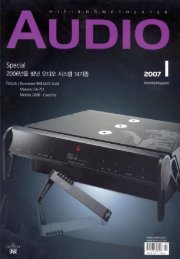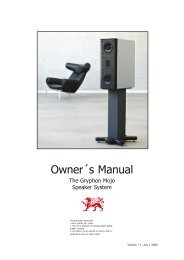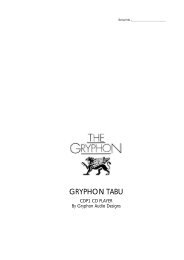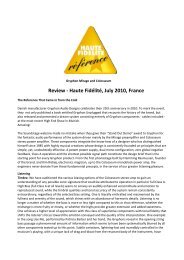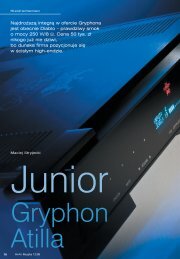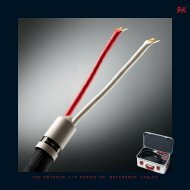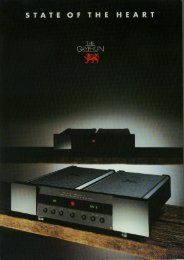Cantata - Gryphon Audio Designs
Cantata - Gryphon Audio Designs
Cantata - Gryphon Audio Designs
You also want an ePaper? Increase the reach of your titles
YUMPU automatically turns print PDFs into web optimized ePapers that Google loves.
EQUIPMENT REVIEW<br />
impregnated are the work of Steen<br />
Duelund, as are the stacked foil<br />
capacitors, potted in epoxy to<br />
resist mechanical interference.<br />
The speaker cabinet<br />
is mounted to the<br />
leading edge of the<br />
dedicated aerofoil<br />
section stand.<br />
This has dimpled<br />
aluminium side<br />
panels, coupled to<br />
extruded alloy leading<br />
and trailing edges that<br />
provide a textural<br />
contrast to the solid<br />
methacrylate end plates<br />
that top and tail the whole<br />
assembly. The stand contains<br />
the crossover, isolating it from<br />
the mechanical interference<br />
of the drive-units. The speaker<br />
cabinet is part wrapped in Nappa<br />
hide, part with brushed and<br />
anodised aluminium panels. The<br />
black finish sent for review is standard,<br />
but there are a host of colour and<br />
material options for a slightly less<br />
monolithic appearance.<br />
The base plate of the <strong>Cantata</strong><br />
carries an inset panel that mounts<br />
a single pair of solid copper binding<br />
posts and a small, multi-pin connector<br />
for the Q controller. The rear edge is<br />
cut away to accept the solid aluminium<br />
cross member and its two hard rubber<br />
feet. The front edge is tapped to take<br />
a single composite cone, designed<br />
to level the speaker and act as a<br />
mechanical ground for the cabinet.<br />
The front tip of the baseplate also<br />
contains a recessed red LED that gives<br />
you muted confirmation of the status<br />
of the active circuitry.<br />
Along with the <strong>Cantata</strong>s, <strong>Gryphon</strong><br />
also supplied their Sonata line-stage<br />
and massive Antileon power-amp, as<br />
well as a complete set of cables. It’s an<br />
imposing set-up when it’s all stacked<br />
together. I ran the <strong>Cantata</strong>s in the<br />
context of this complete system, but<br />
also with the Hovland HP100/RADIA<br />
combination. Sources were the Classe<br />
Omega SACD, Wadia 861 and the<br />
Clearaudio Master Reference/Groove<br />
record player. Set-up instructions<br />
for the speakers are extremely<br />
precise as regards positioning,<br />
the final outcome agreeing<br />
almost exactly with my<br />
generally preferred location,<br />
and once level they were<br />
toed in to point directly<br />
at the listener.<br />
What can I tell you<br />
about the <strong>Cantata</strong>s’<br />
sound? Well, that’s an<br />
interesting question,<br />
and not just because<br />
of the variables<br />
inherent in their<br />
design. Indeed,<br />
the Q Controller<br />
is simplicity itself in<br />
operation, and the correct<br />
setting was immediately<br />
apparent. If you need<br />
help deciding which<br />
setting suits your<br />
room then you’ve<br />
probably already<br />
spent too<br />
much on hi-fi!<br />
What’s more,<br />
experiments<br />
with and without<br />
the Q Controller in the system,<br />
as well as with its own Bypass<br />
switch quickly established<br />
its wholly positive influence.<br />
If there was any loss of<br />
information, transparency<br />
or fine detail with it in<br />
circuit then I couldn’t<br />
detect it. The upside of<br />
using it was a dramatic<br />
increase in dimensionality,<br />
freedom in the bass,<br />
general presence<br />
and focus.<br />
It was if the whole<br />
performance<br />
suddenly locked<br />
together and hit the<br />
groove. Both the band and the music<br />
took on a new sense of substance and<br />
purpose. <strong>Gryphon</strong> certainly seem to<br />
have maximised the benefits of their<br />
chosen approach whilst avoiding the<br />
major pitfalls that have marred past<br />
attempts. Having said that, the <strong>Cantata</strong><br />
isn’t exactly cheap and the Q Controller<br />
presumably represents a significant<br />
proportion of the cost. But then, if<br />
a job’s worth doing, it’s worth doing<br />
well, and the results literally speak for<br />
themselves.<br />
The other slightly contentious<br />
element in the <strong>Cantata</strong> is the biasing<br />
of its crossover capacitors. Once again<br />
the case is easily proved – simply<br />
disconnect the cables. Do so and the<br />
speaker will sound initially quicker<br />
and more transparent, if a little leaner.<br />
But reconnect the bias cables and the<br />
gain in substance, colour and image<br />
coherence is too significant to miss.<br />
Once again, <strong>Gryphon</strong> seem to have<br />
got their sums right.<br />
So, given that the technology works,<br />
how does it leave<br />
the speaker<br />
sounding?<br />
In the best<br />
tradition of<br />
high-quality,<br />
compact twoway<br />
speakers,<br />
that’s a hard<br />
one to pin<br />
down. Play with<br />
the <strong>Cantata</strong>s and<br />
a house full of<br />
equipment for a few<br />
weeks and the first<br />
thing you learn is that<br />
these are the closest thing<br />
to sonic chameleons you’re<br />
ever likely to come across.<br />
The second is that whatever<br />
limitations you detect are<br />
more likely to be down to<br />
the partnering equipment than<br />
the speakers them-selves. Every<br />
time I thought I’d finally put my<br />
finger on the nature of the beast,<br />
92



